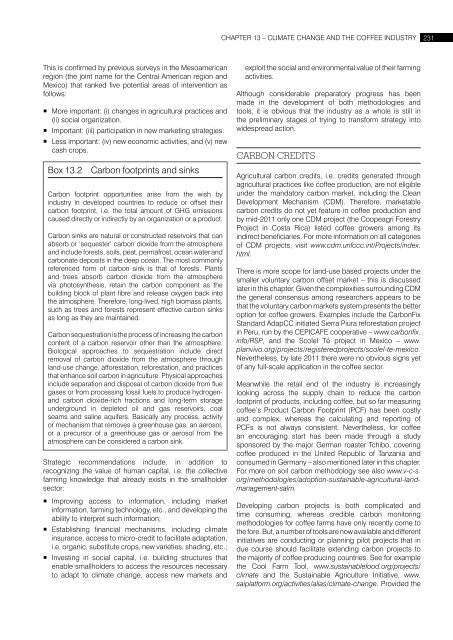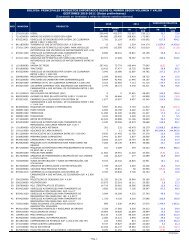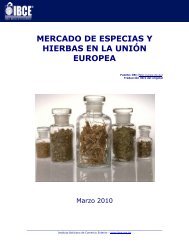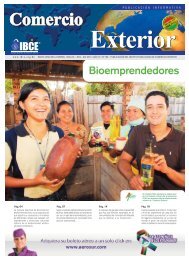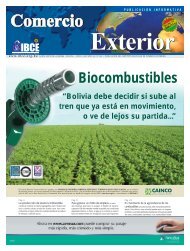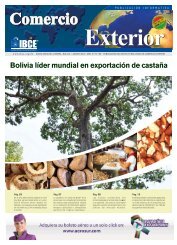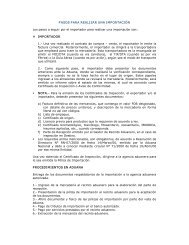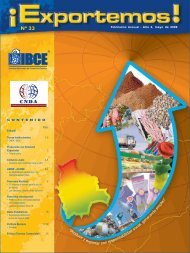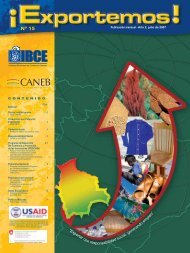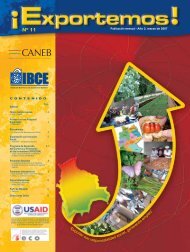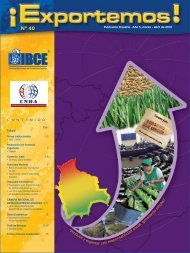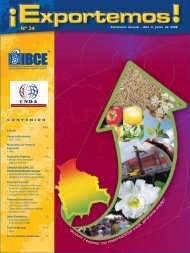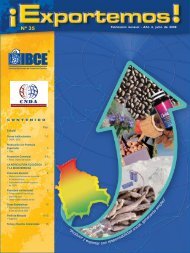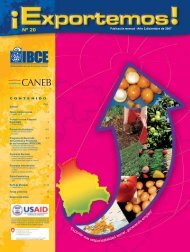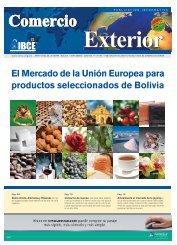The Coffee Exporter's Guide - International Trade Centre
The Coffee Exporter's Guide - International Trade Centre
The Coffee Exporter's Guide - International Trade Centre
- TAGS
- www.ibce.org.bo
Create successful ePaper yourself
Turn your PDF publications into a flip-book with our unique Google optimized e-Paper software.
This is confi rmed by previous surveys in the Mesoamerican<br />
region (the joint name for the Central American region and<br />
Mexico) that ranked fi ve potential areas of intervention as<br />
follows:<br />
� More important: (i) changes in agricultural practices and<br />
(ii) social organization.<br />
� Important: (iii) participation in new marketing strategies.<br />
� Less important: (iv) new economic activities, and (v) new<br />
cash crops.<br />
Box 13.2 Carbon footprints and sinks<br />
Carbon footprint opportunities arise from the wish by<br />
industry in developed countries to reduce or offset their<br />
carbon footprint, i.e. the total amount of GHG emissions<br />
caused directly or indirectly by an organization or a product.<br />
Carbon sinks are natural or constructed reservoirs that can<br />
absorb or ‘sequester’ carbon dioxide from the atmosphere<br />
and include forests, soils, peat, permafrost, ocean water and<br />
carbonate deposits in the deep ocean. <strong>The</strong> most commonly<br />
referenced form of carbon sink is that of forests. Plants<br />
and trees absorb carbon dioxide from the atmosphere<br />
via photosynthesis, retain the carbon component as the<br />
building block of plant fi bre and release oxygen back into<br />
the atmosphere. <strong>The</strong>refore, long-lived, high biomass plants,<br />
such as trees and forests represent effective carbon sinks<br />
as long as they are maintained.<br />
Carbon sequestration is the process of increasing the carbon<br />
content of a carbon reservoir other than the atmosphere.<br />
Biological approaches to sequestration include direct<br />
removal of carbon dioxide from the atmosphere through<br />
land-use change, afforestation, reforestation, and practices<br />
that enhance soil carbon in agriculture. Physical approaches<br />
include separation and disposal of carbon dioxide from fl ue<br />
gases or from processing fossil fuels to produce hydrogen-<br />
and carbon dioxide-rich fractions and long-term storage<br />
underground in depleted oil and gas reservoirs, coal<br />
seams and saline aquifers. Basically any process, activity<br />
or mechanism that removes a greenhouse gas, an aerosol,<br />
or a precursor of a greenhouse gas or aerosol from the<br />
atmosphere can be considered a carbon sink.<br />
Strategic recommendations include, in addition to<br />
recognizing the value of human capital, i.e. the collective<br />
farming knowledge that already exists in the smallholder<br />
sector:<br />
� Improving access to information, including market<br />
information, farming technology, etc., and developing the<br />
ability to interpret such information;<br />
� Establishing fi nancial mechanisms, including climate<br />
insurance, access to micro-credit to facilitate adaptation,<br />
i.e. organic, substitute crops, new varieties, shading, etc.;<br />
� Investing in social capital, i.e. building structures that<br />
enable smallholders to access the resources necessary<br />
to adapt to climate change, access new markets and<br />
CHAPTER 13 – CLIMATE CHANGE AND THE COFFEE INDUSTRY 231<br />
exploit the social and environmental value of their farming<br />
activities.<br />
Although considerable preparatory progress has been<br />
made in the development of both methodologies and<br />
tools, it is obvious that the industry as a whole is still in<br />
the preliminary stages of trying to transform strategy into<br />
widespread action.<br />
CARBON CREDITS<br />
Agricultural carbon credits, i.e. credits generated through<br />
agricultural practices like coffee production, are not eligible<br />
under the mandatory carbon market, including the Clean<br />
Development Mechanism (CDM). <strong>The</strong>refore, marketable<br />
carbon credits do not yet feature in coffee production and<br />
by mid-2011 only one CDM project (the Coopeagri Forestry<br />
Project in Costa Rica) listed coffee growers among its<br />
indirect benefi ciaries. For more information on all categories<br />
of CDM projects, visit www.cdm.unfccc.int/Projects/index.<br />
html.<br />
<strong>The</strong>re is more scope for land-use based projects under the<br />
smaller voluntary carbon offset market – this is discussed<br />
later in this chapter. Given the complexities surrounding CDM<br />
the general consensus among researchers appears to be<br />
that the voluntary carbon markets system presents the better<br />
option for coffee growers. Examples include the CarbonFix<br />
Standard AdapCC initiated Sierra Piura reforestation project<br />
in Peru, run by the CEPICAFE cooperative – www.carbonfi x.<br />
info/RSP, and the Scolel Té project in Mexico – www.<br />
planvivo.org/projects/registeredprojects/scolel-te-mexico.<br />
Nevertheless, by late 2011 there were no obvious signs yet<br />
of any full-scale application in the coffee sector.<br />
Meanwhile the retail end of the industry is increasingly<br />
looking across the supply chain to reduce the carbon<br />
footprint of products, including coffee, but so far measuring<br />
coffee’s Product Carbon Footprint (PCF) has been costly<br />
and complex, whereas the calculating and reporting of<br />
PCFs is not always consistent. Nevertheless, for coffee<br />
an encouraging start has been made through a study<br />
sponsored by the major German roaster Tchibo, covering<br />
coffee produced in the United Republic of Tanzania and<br />
consumed in Germany – also mentioned later in this chapter.<br />
For more on soil carbon methodology see also www.v-c-s.<br />
org/methodologies/adoption-sustainable-agricultural-landmanagement-salm.<br />
Developing carbon projects is both complicated and<br />
time consuming, whereas credible carbon monitoring<br />
methodologies for coffee farms have only recently come to<br />
the fore. But, a number of tools are now available and different<br />
initiatives are conducting or planning pilot projects that in<br />
due course should facilitate extending carbon projects to<br />
the majority of coffee producing countries. See for example<br />
the Cool Farm Tool, www.sustainablefood.org/projects/<br />
climate and the Sustainable Agriculture Initiative, www.<br />
saiplatform.org/activities/alias/climate-change. Provided the


